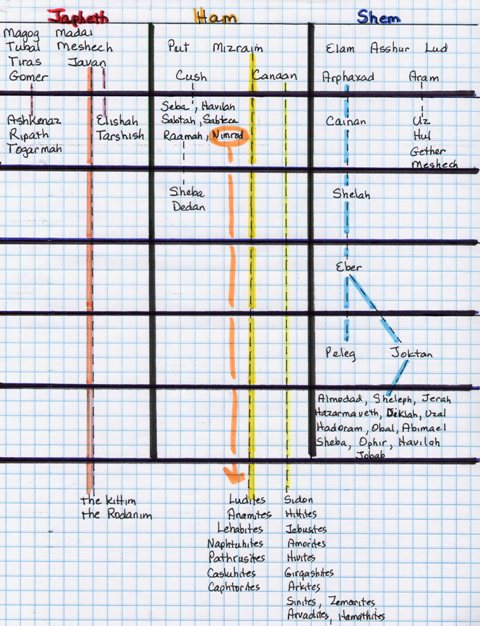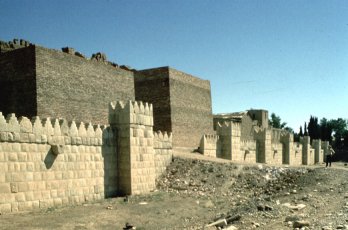|
Genealogies of Genesis 5, 10, and 11
Robert Bradshaw's web book, Creationism and the Early Church, is a study of the beliefs of the early church fathers regarding creation up to the time of Augustine. In chapter 3, there is a chart which summarizes what the early church fathers thought in terms of the age of the world when they were alive, 2000 years ago. Here it is: Specific Statements Made by the Early Church Writers Concerning the Age of the Earth
Two others not on Bradshaw's chart above are Julius Africanus (died 240 A.D.) who considered creation to have taken place in 5531 B.C. (from his "Fragments of the Chronography" frag. 18.4) and Theophilus of Antioch (115-181) who dated creation at 5518 B.C. +/- 200 years ( letter from Theophilus to Autolycus 3:29). Why, then, are our modern Bibles today giving us an age of about 6000 years since Creation for our time? The answer lies in the Masoretic text, from which all our modern Bibles, including the modern Hebrew, have arisen. The Masoretic is a product of the Council of Jamnia, a series of 'discussion groups' which met about 100 A.D. The Romans has destroyed the Temple in Jerusalem in 70 A.D., and thus also destroyed the original manuscripts of the Scriptures. Copies, of course, remained, primarily known today as the Alexandrian Septuagint (LXX) and the Samaritan Pentateuch. The rabbis, gathered under Rabbi Akiba, wanted to formulate a new 'official' copy of the Hebrew Scriptures. In doing so, they switched from the more ancient paleo Hebrew (sort of like our cursive) to the modern block Hebrew characters. (They also left out the vowel points, which were not restored until 900 A.D., and then on the basis of oral tradition.) Because they wanted to eliminate the ability of the new Christian sect to use the Hebrew scriptures as evidence that Jesus of Nazareth was the Messiah, they altered some of the quotes used by the Christians which came from the Old Testament. This is why many of the quotes used in today's Bibles do not match the referents in the Old Testament. In at least one case (Hebrews 1:6), the referent, Deuteronomy 32:43, is so changed as to be unrecognizable. It is there, however, in the Alexandrian. In addition, the rabbis in the Council felt that the genealogies in Genesis must be wrong. It would be dishonoring to God for a man to wait until after he was a hundred or a hundred and fifty to have a son. So, in many cases, they simply dropped the cipher for "100" from the ages of many of the men at the time their mentioned son was born. This effectively chops over 1300 years off the age of the earth in terms of the Masoretic texts. Here is Genesis 5, comparing the ages as given in the more ancient texts with those in the more recent (from 100 A.D.) Masoretic text
Genesis 11, doing the same thing:
each total adds 2 years since Shem had Arphaxad two years after the Flood. * The Alexandrian includes a second Cainan here, which Luke picks up. However this may be a mistake as both Josephus and the Samaritan Pentateuch omit him. There is another clue, as well, that his inclusion may be a mistake. If the Tablet Theory is correct, then Shem signs off his tablet in Genesis 11:10 immediately AFTER the Tower of Babel (Genesis 11:1-9). This means he was still alive at that time. If the second Cainan is added in, however, Shem would be dead before he finished his tablet telling about the Babel catastrophe. ** Abraham's birth is figured from the age at which he was when his father, Terah, died. Although the Bibles give Terah's age as 70, we must assume that was his age when his first son was born. Abraham was 75 when his father died at age 205. That makes Terah 130 when Abraham was born. Total years from Creation to Abraham
Abraham was born in 2322 B.C. Adding this to the Alexandrian age gives 5785 years from Creation to Christ. Adding to the Masoretic, however, only gives 4429 years from Creation to Christ. One of the reasons for the discrepancies between the Alexandrian as we have given it and the age as figured by most of the above listed church fathers is that Terah is listed as 70 when his first son was born, but that was evidently not Abraham, for Abraham was about 75 when his father died at 205 years old (Genesis 11:32, Genesis 12:4), and that would make Terah, as we show above, about 130 when Abraham was born. This does not answer for the full discrepancy, but it does narrow the gap a bit. The one thing which does seem evident is that the early church fathers did not consider the 'second Cainan' to be part of the true genealogy after the Flood. It is also interesting that all of the church fathers listed above lived after the Council of Jamnia in 100 A.D., and that is when the ciphers for '100' were dropped from so many of the ages in Genesis 5 and 11, as shown above. Evidently the church fathers simply did not accept these revised ages of the men when the named son was born. Genesis 10 The following chart (very homemade) is taken from Genesis 10. There are some interesting notes which should be made here:
About Nimrod In Genesis 10, There is a straight listing of genealogies except for one interesting -- apparent -- insertion: This is found in verses 8-12. First, verse 6 lists the sons of Ham and verse 7 the sons of Cush. They are all referred to as 'sons.' but in verse 8, we have an interesting difference. The NIV states "Cush was the father of Nimrod." The KJV states "and Cush begat Nimrod." Nimrod is not listed as one of the sons of Cush in verse 7. Then there is a bit about Nimrod which is not in the pattern of any of the other lists of fathers and sons: Genesis 10:8-12 NIV -- Cush was the father of Nimrod, who grew to be a mighty warrior on the earth. He was a mighty hunter before the Lord; that is why it is said, "Like Nimrod, a mighty hunter before the Lord." The first centers of his kingdom were Babylon, Erech, Akkad and Calneh, in Shinar. From that land he went to Assyria, where he built Nineveh, Rehoboth Ir, Calah, and Resen, which is between Nineveh and Calah; that is the great city. KJV -- And Cush begat Nimrod: he began to be a mighty one in the earth. He was a mighty hunter before the Lord; wherefore it is said, Even as Nimrod, the mighty hunter before the Lord. And the beginning of his kingdom was Babel, and Erech, and Accad, and Calneh, in the land of Shinar. Out of that land went forth Asshur, and builded Nineveh and the city of Rehoboth and Calah, and Resen, between Nineveh and Calah: the same is a great city. LXX -- And Cush begat Nebrod: he began to be a giant upon the earth. He was a giant hunter before the Lord God; therefore they say, As Nebrod, a giant hunter before the Lord. And the beginning of his kingdom was Babylon, and Orech, and Archad, and Chalanne in the land of Senaar. Out of that land came Assur, and built Ninevi, and the city Rhooboth, and Chalach, and Dase betwenn Ninevi and Chalach: this is the great city. Hebrew -- And Cush fathered Nimrod; he began to be a hero in the land. He was a great hunter before Jehovah; so it is said, Even as Nimrod, the great hunter before Jehovah. And was the beginning of his kingdom Babel, and Erech, and Accad, and Calneh, in the land of Shinar. Out of land that he went forth to Assyria and built Nineveh, and Rehoboth, and the city Calah, and Resen, between Nineveh and Calah, which is the city great. The same word that translates "giant" also translates "hero," and "mighty one." This should be noted for those who think physical giants roamed the earth at one time. "Before" is Strongs 6440, which is "paniym" or "paneh" -- meaning "to face, before, against, anger, as long as, battle, because of, beseech, countenance, inquire, face, favor, fear, forefront, impudent, over againt, presence, prospect." comes from 6437 -- panah -- to turn (by implication a face, to cast out, to go away, to lie, to prepare, to turn aside, to turn away, to turn back). Was Nimrod a mighty hunter in honor of the Lord or in rebellion (in His face) against Him? The language itself is not really clear. We only have tradition here. However, there are at least eight cities associated with him, and this is far too many for two generations after the Deluge. This is a strong indication that Nimrod was a descendent of Cush, and not a son. The cities in Mesopotamia today with the names of Nineveh and such are ancient and giant, walled structures. Looking back to the maps at the time of Babel, it can be seen that the Mesopotamian area was under water until the time of Peleg, so this again puts Nimrod much later historically than commonly believed. Below is a partial reconstruction of some of those ancient walls.
Cities of this size are associated with the earliest Mesopotamian civilizations which date much later than the Flood or Babel. In addition, as shown in the Babel material, this area was under water before the time of Peleg. So while Cush is definitely associated with Babel, we are suggesting that Nimrod came much later and that he was either one of the first of the kings in this area or was a general in an army. The reference to him being a mighty hunter may be an implication of danger from the wild animals which were still migrating away from the Babel area. The African continent is famous for its lions and other wild cats. These are the world's only true mammalian carnivores and they may well have become a danger to the people living in that area. One translation of Nimrod's name is that it is a condensation of "leopard subduer" or "nimr rud". It's an interesting thought.... Two translations above say he came from the area of Babel, and two from Babylon. These two names have a history of being interchangeable, but that may be a mistaken tradition. It is interesting that the oldest of the translations says he came from the area of Senaar, which, as mentioned in the section on Babel, still exists today in the Sudan. If Babel was there, and the evidence seems to indicate that, then a migration across the land north of the Red Sea and into the now dry Mesopotamian area would have taken place about the time of Nimrod.
This concludes the study on Genesis 1-11. We have presented what we have found in terms of data, and, in so doing, have found it fits rather precisely with what the Bible tells us happened in those early generations. Please remember, however, that this material is not the final word. We not only would appreciate knowing, but NEED to know, any data which would contradict this material. Please feel free to email us with comments, questions or data.
|


